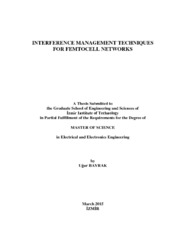Please use this identifier to cite or link to this item:
https://hdl.handle.net/11147/4344Full metadata record
| DC Field | Value | Language |
|---|---|---|
| dc.contributor.advisor | Özbek, Berna | en_US |
| dc.contributor.author | Bayrak, Uğur | - |
| dc.date.accessioned | 2015-11-24T09:20:33Z | |
| dc.date.available | 2015-11-24T09:20:33Z | |
| dc.date.issued | 2015-03 | |
| dc.identifier.citation | Bayrak, U. (2015). Interference management techniques for femtocell networks. Unpublished master's thesis, İzmir Institute of Technology, İzmir, Turkey | en_US |
| dc.identifier.uri | http://hdl.handle.net/11147/4344 | |
| dc.description | Thesis (Master)--Izmir Institute of Technology, Electronics and Communication Engineering, Izmir, 2015 | en_US |
| dc.description | Includes bibliographical references (leaves: 77-78) | en_US |
| dc.description | Text in English; Abstract: Turkish and English | en_US |
| dc.description | xi, 80 leaves | en_US |
| dc.description.abstract | The need for high capacity and data rate increases with the growing demand for wireless communication. In order to meet this demand, one of the most effective ways of improving capacity and data rate is deployment of femtocell networks which are considered to be a promising technique for future wireless networks. However, mass deployment of these low-power base stations brings many challenges. Interference management will be one of the major challenges for the dense deployment scenarios of femtocells in coverage of the macro base stations. To cope with interference problem, there are many interference management techniques. In this thesis, power control and beamforming techniques are implemented separately and jointly in order to deal with cross-tier downlink interference which occurs between macro base station and users of femtocell. In this two-tier network system involving femtocell and macrocell layers, power control problem, first, is investigated. Feasible transmission power region for femtocell is determined with respect to the user locations so that targeted signal-to-interference-plus-noise-ratio (SINR) values are satisfied. Secondly, beamforming technique is applied using partial zero-forcing method. In this method, beamforming vectors are designed to remove cross-tier interference. It is observed that SINR of macro base station’s user does not undergoes any degradation in the nearfield region of femtocell. Finally, we apply these two techniques jointly. Since both interference suppression and power-efficiency is provided, joint technique seems to be a viable and environment-friendly solution for femtocell networks. | en_US |
| dc.description.abstract | Yüksek kapasite ve veri hızı gereksinimi kablosuz haberleşme için yükselen taleple birlikte artmaktadır. Bu talebi karşılamak için kapasite ve veri hızını geliştirmenin en etkili yollarından biri gelecek nesil kablosuz ağlar için ümit verici bir teknik olacağı düşünülen ev baz istasyonlarının kullanılmasıdır. Bununla beraber bu düşük güçlü baz istasyonlarının yoğun olarak yerleştirilmesi pek çok zorluğu beraberinde getirmektedir. Girişim yönetimi, ev baz istasyonlarının makro baz istasyonlarının kapsama alanlarında yoğun olarak yerleştirilme senaryoları için başlıca zorluklardan biri olacaktır. Girişim sorunuyla başa çıkmak için birçok teknik vardır. Bu tezde, baz istasyonundan kullanıcılara etki eden farklı katmanlar arasındaki girişimi ele almak için güç kontrolü ve hüzmeleme teknikleri ayrı ayrı ve ortaklaşa gerçekleştirilmiştir. Ev baz istasyonu ve makro baz istasyonunu içeren iki katmanlı ağ sisteminde, güç kontrol problemi ilk olarak incelenmiştir. Hedeflenen SINR değerlerinin sağlanması amacıyla ev baz istasyonu için uygulanabilir iletim güç aralığı kullanıcıların konumlarına göre belirlenmiştir. İkinci olarak, hüzmeleme tekniği kısmi ZF metodu kullanılarak uygulanmıştır. Bu yöntemde, katmanlar arası girişimi ortadan kaldırılmak için hüzmeleme ağırlık vektörleri dizayn edilmiştir. Makro baz istasyonu kullanıcısına ait SINR değerinin ev baz istasyonuna yakın alanlarda herhangi bir azalmaya uğramadığı gözlenmektedir. Son olarak, bu iki teknik ortaklaşa uygulanmıştır. Uygulanan bu ortak teknik, hem girişimin yok edilmesi hem de güç verimliliği sağlandığından ev baz istasyonları için uygun ve çevre dostu bir çözüm olarak görünmektedir. | en_US |
| dc.language.iso | en | en_US |
| dc.publisher | Izmir Institute of Technology | en_US |
| dc.rights | info:eu-repo/semantics/openAccess | en_US |
| dc.subject | Femtocells | en_US |
| dc.subject | Wireless networks | en_US |
| dc.subject | Multiple input single output | en_US |
| dc.title | Interference management techniques for femtocell networks | en_US |
| dc.title.alternative | Ev baz istasyonu ağları için girişim yönetimi teknikleri | en_US |
| dc.type | Master Thesis | en_US |
| dc.institutionauthor | Bayrak, Uğur | - |
| dc.department | Thesis (Master)--İzmir Institute of Technology, Electrical and Electronics Engineering | en_US |
| dc.relation.publicationcategory | Tez | en_US |
| item.grantfulltext | open | - |
| item.cerifentitytype | Publications | - |
| item.languageiso639-1 | en | - |
| item.openairecristype | http://purl.org/coar/resource_type/c_18cf | - |
| item.fulltext | With Fulltext | - |
| item.openairetype | Master Thesis | - |
| Appears in Collections: | Master Degree / Yüksek Lisans Tezleri Sürdürülebilir Yeşil Kampüs Koleksiyonu / Sustainable Green Campus Collection | |
Files in This Item:
| File | Description | Size | Format | |
|---|---|---|---|---|
| T001361.pdf | MasterThesis | 1.42 MB | Adobe PDF |  View/Open |
CORE Recommender
Page view(s)
84
checked on Jul 22, 2024
Download(s)
44
checked on Jul 22, 2024
Google ScholarTM
Check
Items in GCRIS Repository are protected by copyright, with all rights reserved, unless otherwise indicated.